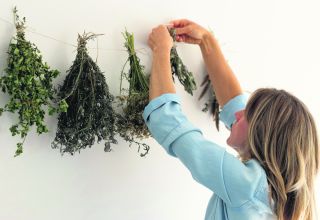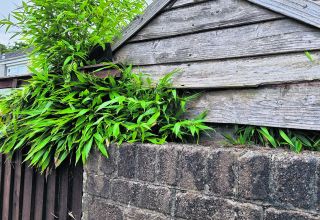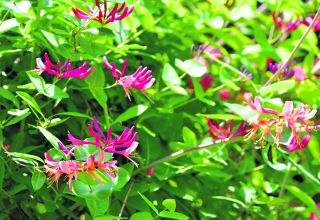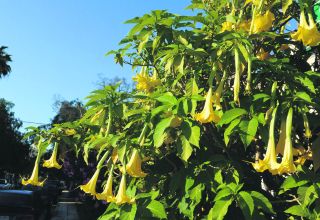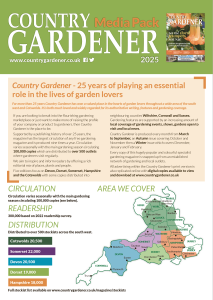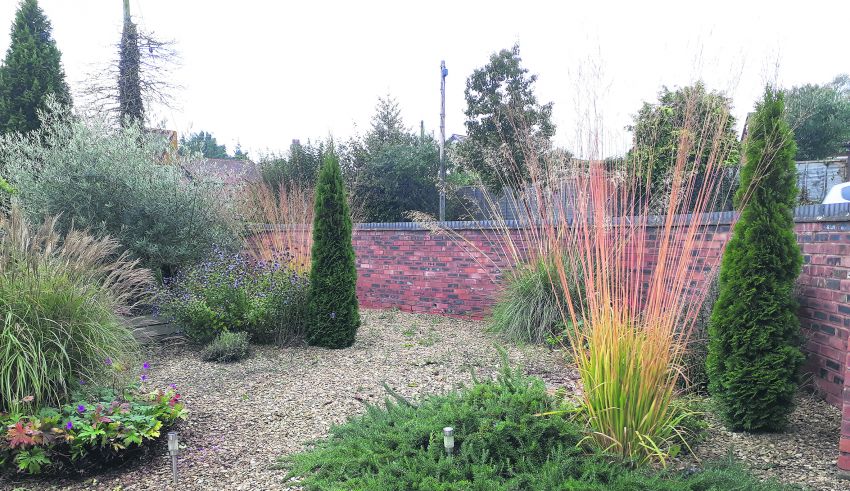
Discover how to stage an end of season plant performance in your garden in the form of evergreens, foliage, berries, and seed heads with designer and plant specialist Carol Smith.
When flowers fade, leaves drop and early morning dew covers the ground, it’s as if plants know the vibrant, colourful main summer performance is drawing to its close; the last month of autumn, the final act of November has arrived.
A time to reflect on the pandemic difficulties, which to a certain point have been offset by more enjoyable times of the past year in our greenspace, enjoyed by so many more people than previous years.
Thoughts of shorter days, cooler temperatures, and a dull looking garden create a sense of dread for winter to come, even the hot chocolate is a poor substitute for warmth and colour!
From a practical perspective, the reduction in heat and stage lighting – the sun, triggers a slowdown of growth, flower, and leaf production recognisable as autumn foliage colour and falling leaves, a signal to us that winter is on its way, the natural cycle of nature that is beyond our control.
Let’s keep our spirits up and stay with the good news to discover how the garden can keep us interested and engaged when its bouquet of many flowers is not available.
Striking colour combinations of plants in full summer costume deliver the wow factor and are a delight to behold; be assured the end of season performance can deliver the same level of impact. To ease the passage into winter we can bring late autumn/winter colour to the garden in the form of evergreens, foliage, berries, and seed heads rather than flowers. When backlit by low sun and pale watery blue skies there is a myriad of plants which are at their best and will provide a wonderful glowing finale to the garden year before it slips into its winter slumber.
The autumnal November finale wants to take a final bow with a mellow glow, a soft tranquillity in the garden, stillness that speaks of winter rest yet excites with small quantities of high impact. More subtle plant qualities that are at their best at this time of year, rather than the full-on dramatic theatre of summer draw our attention to choosing plants for specific characteristics blended with a restrained colour palette of russets, rich reds, golds, terracotta, all softened with creamy buffs and beiges that will ensure you have a memorable finale.
So, what are these plant qualities? Think of them as planting design tools and three of the finest are form, colour and texture, key to designing a successful planting scheme that provides seasonal interest. The first act is about Form, which without its support act of colour in the shape of stems – Cornus family, foliage, and berries – some shrubs and small trees, although colourful can look a little static.
A second act of late colour found in bulbs such as Hesperanthus, Nerine bowdenii, Colchicum (autumn crocus), bark – three of the best are Prunus serrula, Acer davidii and Betula ‘Jacquemontii’ which positively glows in the dark! Supported by a final act of movement and texture with stunning grasses it is sure to create an unforgettable finale and receive a standing ovation when brought together as a final performance.
Let’s take a deeper look.
FORM
Great examples are commonly seen in the strong shapes of evergreen conifers, not leylandii! Their striking presence in a border, like a lead actor, cannot be ignored or missed. Varieties such as thuja occidentalis ‘Danica’ provide a strong ball shape, thuja occidentalis ‘Smaragd’ a jewel green architectural cone shape, for a shining golden mound shape you can’t beat Pinus mugo ‘Wintergold’ all bring prominent architectural shape, foliage colour and sometimes cones.
Evergreen shrubs such as Viburnum tinus, gold and green variegated Eleagnus ebbingei ‘Limelight’, the deep wine red of Pittosporum ‘Tom Thumb’– variegated Pittosporums are also available, all play a major role.
A little time, a good ‘evergreens’ book and you can discover the wide variety of foliage colour, berries, and shape available to us, as if that’s not enough to choose from, grasses also play a key role in this final act.
Some are tall and fan shaped such as golden gleaming Molinia ‘Karl Foester’, evergreen Stipa gigantea, short and fan shaped wispy Stipa tenuissima or medium height upright, column shaped calamagrostis which will not be flattened by the strongest winds. Bring in a chorus of stately seed heads of eryngium, fennel and globe artichoke will add an intriguing feature, feed birds and wildlife– some produce a delicate white fluff, and all look enchanting when covered with hoar frost.
COLOUR
Small ornamental trees such as Crataegus, Sorbus, Prunus and Amelanchier may be holding onto a few bonfire-coloured leaves by November but shrubs that produce berries such as the lilac beads of Callicarpa, bright red berries of Nandina domestica and orange or yellow Pyracantha will continue to provide colour right through to January/February unless the birds eat them all!
Late autumn perennials helenium and rudbeckia will flower until the first frosts then display dark, olive shaped seed heads which create silhouettes against creamy grasses or lime green stems of Cornus ‘Flaviramea’, bright orange stems of Cornus ‘Winter Beauty’ and coral red stems of Cornus siberica will offer a splash of glowing colour especially when planted in groups until cut back in January/February.
I mentioned the word ‘static’ earlier which when applied to a garden describes a lack of movement which imparts a sense of heaviness in the garden. The movement of swaying grasses will completely transform this and be absolutely mesmerising to watch. The final element I want to mention is
TEXTURE
A quality that shows itself in many different guises depending on which plant group we are looking at. So, bark and foliage when exploring trees and shrubs, needle, and scale like when exploring conifers, delicate fluffy seed heads when exploring grasses.
There is still time to improve your November garden, plants are readily available in garden centres and it’s still warm enough to plant newly purchased specimens. Notebook and camera in hand, now is the ideal time of year to take a walk around and evaluate how your garden could be improved on a basis of ‘what’s missing’?
Is it lacking in autumn foliage colour and berries, evergreen architectural shape and form, late colourful autumn flowering bulbs? How does it feel? A still heavy sense could be transformed to light and airy with some grasses.
Introduce a plant group of one plant for each element, a strong architectural conifer with an evergreen shrub and colourful berries, a perennial with rich brown seed heads, a golden grass and your appealing late autumn/early winter garden can be born. Just one small late autumn/early winter group could become the part of the garden that appeals for many different reasons and raises your spirits when you need it most.
Take an inspirational visit to a garden such as Knoll grasses or Trentham, whose large drifts of golden grasses, punctuated by sprays of rich brown seed heads held aloft against a backcloth of glowing autumn foliage and berries will be just the impetus you need to create a garden encore that raises the curtain time and time again!
“Notebook and camera in hand, now is the ideal time of year to walk around and evaluate how your garden could be improved on a basis of ‘what’s missing’?”






